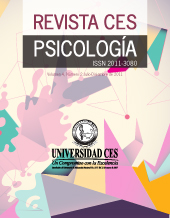Facial-affective communication and verbal relational offers during ruptures and resolution strategies: A single case study
DOI:
https://doi.org/10.21615/cesp.13.3.11Keywords:
Ruptures, Resolutions, Facial-Affective Communication, Relational Offers, Psychotherapeutic Process, Therapeutic AllianceAbstract
Research on the therapeutic relationship has underscored its central role for the therapeutic change process, indicating the relevance of determining the specific elements and mechanisms involved in its configuration (Knobloch-Fedders, Elkin, & Kiesler, 2014). Research on ruptures of the therapeutic relationship has yielded particular contributions to better understanding the interpersonal negotiation process involved in the patient-therapist interaction. Although previous studies have contributed to the objective characterization and the exhaustive description of ruptures, more research is needed to further specify markers that allow a better understanding about how patterns of affective regulation between patient and therapist are involved and contribute to the emergence of these events and the attempts at reparation. The aim of this study is to characterize patient’s and therapist’s facial-affective behavior associated to verbal relational offers (RO) during rupture (R) and resolution strategy (RS) events in a brief psychodynamic therapy. Facial-affective behavior was determined using the Facial Action Coding System (FACS), ROs were derived from the content analysis of session transcripts, and R and RS were determined using the 3RS. Nested analyses were carried to establish associations between variables. Results indicate characteristic patient-therapist facial-verbal regulatory patterns for both rupture and resolution strategy events. These findings underscore the value of combining multiple approaches to allow an access to observable indicators of dyadic affect regulatory processes that can contribute to better understand and be attentive to the oscillations of the therapeutic relationship.
Downloads
References
Altimir, C., &. Jiménez, J.P. (2020). Walking the middle ground between hermeneutics and science: A research proposal on psychoanalytic process. The International Journal of Psychoanalysis, 101(3), 496-522 https://doi.org/10.1080/00207578.2020.1726711
Altimir, C., Krause, M., de la Parra, G., Dagnino, P., Tomicic, A., Valdés, N., … Vilches, O. (2010). Clients', therapists', and observers' agreement on the amount, temporal location, and content of psychotherapeutic change and its relation to outcome. Psychotherapy Research, 20, 4, 472 - 487. https://doi.org/10.1080/10503301003705871
Anstadt, T., Merten, J., Ullrich, B., & Krause, R. (1997). Affective dyadic behavior, core conflictual relationship themes, and success of treatment. Psychotherapy Research, 7, 397-417. https://doi.org/10.1080/10503309712331332103
Aron, L. (1996). A meeting of minds: Mutuality in psychoanalysis. Hillsdale, NJ: Analytic Press.
Bänninger-Huber, E. (1992). Prototypical affective microsequences in psychotherapeutic interaction. Psychotherapy Research, 2, 291-306. https://doi.org/10.1080/10503309212331333044
Bänninger-Huber, E., & Widmer, C. (1999). Affective relationship patterns and psychotherapeutic change. Psychotherapy Research, 9, 74-87. https://doi.org/10.1080/10503309912331332601
Barros, P., Altimir, C., & Pérez, J.C. (2016). Patients’ facial-affective regulation during episodes of rupture of the therapeutic alliance / Regulación afectivo-facial de pacientes durante episodios de ruptura de la alianza terapéutica. Estudios de Psicología, 37, 2-3, 580-603. https://doi.org/10.1080/02109395.2016.1204781
Benecke, C., & Krause, R. (2005). Facial affective relationship offers of patients with panic disorder. Psychotherapy Research, 15, 178-187. https://doi.org/10.1080/10503300512331335048
Benecke, C., Peham, D., & Bänninger-Huber, E. (2005). Nonverbal relationship regulation in psychotherapy. Psychotherapy Research, 15, 81-90. https://doi.org/10.1080/10503300512331327065
Castonguay, L.G., Goldfried, M.R., Wiser, S., Raue, P.J., & Hayes, A.M. (1996). Predicting the effect of cognitive therapy for depression: A study of unique and common factors. Journal of Consulting and Clinical Psychology, 64, 497-504. https://doi.org/10.1037/0022-006X.64.3.497
Coutinho, J., Ribeiro, E., Fernandes, C., Sousa, I., & Safran, J. D. (2014). The development of the therapeutic alliance and the emergence of alliance ruptures. Anales de Psicología, 30(3), 985–994. http://dx.doi.org/10.6018/analesps.30.3.168911
Coutinho, J., Ribeiro, E., Hill, C., & Safran, J. D. (2011). Therapists’ and clients’ experiences of alliance ruptures: A qualitative study. Psychotherapy Research, 21(5), 525–540. http://dx.doi.org/10.1080/10503307.2011.587469
de la Parra, G., von Bergen, A., & del Río, M. (2002). Primeros hallazgos de la aplicación de un instrumento que mide resultados psicoterapéuticos en una muestra de pacientes y de población general. Revista Chilena de Neuropsiquiatría, 40, 201-209. http://dx.doi.org/10.4067/S0717-92272002000300003
Dreher, M., Mengele., U., Krause, R., & Kämmerer, A. (2001). Affective indicators of the psychotherapeutic process: An empirical case study. Psychotherapy Research, 11, 99-117. https://doi.org/10.1080/713663855
Ekman, P. (1979). About brows: Emotional and conversational signals. In M von Cranach, K. Foppa, W. Lepenies and D. Ploog (Eds.) (pp. 169-249). Human Ethology. Cambridge, UK: Cambridge University Press.
Ekman, P., & Friesen, W. V. (1978). Facial action coding system: A technique for the measurement of facial movement. Palo Alto, California: Consulting Psychologists Press.
Ekman, P., & Friesen, W. V. (1982). Felt, false, and miserable smiles. Journal of Nonverbal Behavior, 6(4), 238-252. https://doi.org/0191-5886/82/1400-0238
Eubanks, C. F., Muran, J. C., & Safran, J. D. (2015). Rupture Resolution Rating System (3RS): Manual. Technical Report.
Fleiss, J. L., Levin, B., & Cho Paik, M. (1981). Statistical Methods for Rates and Proportions. (3rd. ed). New York: John Wiley & Sons.
Fonagy, P., & G. Moran, (1993). Selecting Single Case Research Designs for Clinicians. In E. N. Miller, L. Luborsky, J. P. Barber, and J. P. Docherty (Eds.). Psychodynamic Treatment Research: A Handbook for Clinical Practice (pp. 62–95). New York: Basic Books.
Horvath, A. O., Del Re, A. C., Flückiger, C., & Symonds, D. (2011). Alliance in individual psychotherapy. Psychotherapy, 48, 9–16. https://doi.org/10.1037/a0022186
Kächele, H. (2020). From case study to single case research: The specimen case Amalia X. In M. Leuzinger-Bohleber, M. Solms, & S. E. Arnold (Eds.). Outcome research and the future of psychoanalysis. Clinicians and researchers in dialogue. (pp. 68-88). New York: Routledge.
Knobloch-Fedders, L. M., Elkin, I., & Kiesler, D.J. (2015). Looking Back, looking Forward: A historical reflection on psychotherapy process research. Psychotherapy Research 25(4), 383–395. https://doi.org/10.1080/10503307.2014.906764
Krause, M., Altimir, C., Pérez, C., & de la Parra, G. (2014). Generic Change Indicators in therapeutic processes with different outcomes. Psychotherapy Research, 25(5), 533-545. https://doi.org/10.1080/10503307.2014.935516.
Krause, M., de la Parra, G., Arístegui, R., Dagnino, P., Tomicic, A., Valdés, N., … Ramírez, M.L. (2007). The evolution of therapeutic change studied through generis change indicators. Psychotherapy Research, 17, 673-689. https://doi.org/10.1080/10503300601158814
Krause, R., & Merten, J. (1999). Affects, Regulation of Relationship, Transference and Countertransference. International Forum of Psychoanalysis, 8, 103-114. https://doi.org/10.1080/080370699436429
Lambert, M. J., Hansen, N. B., Umpress, V., Lunnen, K., Okiishi, J., & Burlingame, G. M. (1996). Administration and scoring manual for the OQ-45.2. Wilmington, DE: American Professional Credentialing Services.
Merten, J. (1997). Facial-affective behavior, mutual gaze, and emotional experience. Journal of Nonverbal Behavior, 21(3), 179-201. https://doi.org/10.1023/A:1024969514170
Merten, J. (2005). Facial microbehavior and the emotional quality of the therapeutic relationship. Psychotherapy Research, 15, 325-333. https://doi.org/10.1080/10503300500091272
Mitchell, S.A. (1988). Relational concepts in psychoanalysis. Cambridge, MA: Harvard University Press.
Norcross, J. C. (2011). Psychotherapy relationships that work: Evidence based responsiveness (2nd ed.). New York: Oxford University Press. https://doi.org/10.1093/acprof:oSo/9780199737208.001.0001
Piper, W.E., Azim, H.F.A., Joyce, A.S., & McCallum, M. (1991). Transference interpretations, therapeutic alliance, and outcome in short term individual psychotherapy. Archives of General Psychiatry, 48, 946-953. http://doi.org/10.1001/archpsyc.1991.01810340078010
Rasting, M., & Beutel, M. (2005). Dyadic affective interactive patterns in the intake interview as a predictor of outcome. Psychotherapy Research, 15(3), 188-198. https://doi.org/10.1080/10503300512331335039
Raudenbush, S. W., Bryk, A. S., Cheong, Y., Congdon, R., & du Toit, M. (2004). HLM6: Linear and non-linear modeling. Chicago: Scientific Software International.
Rozmarin, E., Muran, J. C., Safran, J., Gorman, B., Nagy, J., & Winston, A. (2008). Subjective and intersubjective analyses of the therapeutic alliance in a brief relational therapy. American Journal of Psychotherapy, 62(3), 313-328.
Safran, J. D. (2003). The relational turn, the therapeutic alliance, and psychotherapy research: Strange bedfellows or postmodern marriage? Contemporary Psychoanalysis, 39, 449-475. https://doi.org/10.1080/00107530.2003.10747215
Safran, J. D., & Kraus, J. (2014). Alliance ruptures, impasses, and enactments: A relational perspective. Psychotherapy, 51, 381–387. https://doi.org/10.1037/a0036815
Safran, J. D., & Muran, J, Ch. (2000). Negotiating the therapeutic alliance. A relational treatment guide. New York: The Guilford Press.
Safran, J. D., & Muran, J. Ch. (2006). Has the concept of the therapeutic alliance outlived its usefulness? Psychotherapy: Theory, Research, Practice, Training, 43, 286-291. https://doi.org/10.1037/0033-3204.43.3.286
Safran, J. D., Muran, J. C., Samstag, L. W., & Winston, A. (2005). Evaluating alliance-focused intervention for potential treatment failures: A feasibility study and descriptive analysis. Psychotherapy: Theory, Research, Practice, Training, 42(4), 512–531. https://doi.org/10.1037/0033-3204.42.4.512
Sayette, M. A., Cohn, J. F., Wertz, J. M., Perrott, M. A., & Parrott, D. J. (2001). A psychometric evaluation of the Facial Action Coding System for assessing spontaneous expression. Journal of Nonverbal Behavior, 25(3), 167 - 185. https://doi.org/10.1023/A:1010671109788
Downloads
Published
How to Cite
Issue
Section
License
Copyright (c) 2020 CES Psicología

This work is licensed under a Creative Commons Attribution-NoDerivatives 4.0 International License.
Each manuscript is accompanied by a statement specifyingThat the materials are unpublished, that have not been previously published in printed formatElectronic and that they will not be presented to any other means before knowing the decision of the magazine. ThroughoutIn case, any previous publication, sea in printed or electronic form, must be made known to the editorial staffWriting The authors attach a signed statement stating that, and the manuscript is acceptedFor publication, the rights of reproduction are the exclusive property of the Journal CES Psychology.| Article metrics | |
|---|---|
| Abstract views | |
| Galley vies | |
| PDF Views | |
| HTML views | |
| Other views | |




